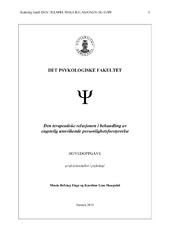| dc.contributor.author | Hage, Maria Befring | |
| dc.contributor.author | Haugsdal, Karoline Lian | |
| dc.date.accessioned | 2020-01-23T03:47:54Z | |
| dc.date.available | 2020-01-23T03:47:54Z | |
| dc.date.issued | 2019 | |
| dc.date.submitted | 2020-01-22T23:00:08Z | |
| dc.identifier.uri | https://hdl.handle.net/1956/21336 | |
| dc.description.abstract | Engstelig unnvikende personlighetsforstyrrelse (EUPF) er relativt hyppig forekommende i Norge, og forbundet med høyt lidelsestrykk. Samtidig er denne pasientgruppen viet lite oppmerksomhet, og det foreligger relativt lite empirisk forskning på effekten av ulike behandlingstilnærminger. Den terapeutiske relasjonen er vurdert som sentral for bedring i alle former for psykoterapi, og har særlig betydning i behandlingen av personlighetsforstyrrelser. Denne oppgaven belyser og diskuterer hvordan kjernepatologien forbundet med EUPF kan medføre utfordringer i den terapeutiske relasjonen. Vi utforsker også hvordan utfordringene knyttet til EUPF kan forstås og håndteres innenfor det dynamiske og kognitive atferdsterapeutiske perspektivet, med utgangspunkt i mentaliseringsbasert terapi, affektfobiterapi og kognitiv terapi for personlighetsforstyrrelser. Beskrivelsen av den terapeutiske relasjonen tar utgangspunkt i inndelingen til Gelso og Carter (1985) bestående av de tre komponentene den personlige relasjonen, arbeidsalliansen, overføring- og motoverføringsreaksjoner. Samlet viser gjennomgangen at trekk forbundet med EUPF kan skape et vanskeligere utgangspunkt for etablering av en god terapeutisk relasjon, men at bevissthet om sentrale trekk ved pasientgruppen og forståelse av terapirelasjonen kan danne grunnlag for å utvikle en god og effektiv terapeutisk relasjon. Gjennomgangen kan bidra til økt forståelse av utfordringer i dannelsen av en terapeutisk relasjon med denne pasientgruppen. | en_US |
| dc.description.abstract | Avoidant personality disorder (AVPD) is relatively prevalent in Norway, and is associated with substantial suffering. However, it is devoted little attention and there is limited empirical research regarding the effect of different treatment approaches. The therapeutic relationship is considered central to improvement in all forms of psychotherapy, and is of particular importance in the treatment of personality disorders. In this paper we highlight and discuss how the core pathology in AVPD can pose challenges in the therapeutic relationship. We will also explore how these challenges can be understood and managed in treatment approaches within the dynamic and cognitive behavioral perspective, respectively, mentalization-based therapy, affect phobia therapy and cognitive therapy for personality disorders. We will describe the therapeutic relationship based on Gelso and Carter's (1985) classification consisting of the three components the personal relationship, the working alliance, transference and countertransference. Overall, the review indicates that the traits associated with AVPD will create a more difficult starting point in establishing a good therapeutic relationship, but that awareness of the central traits of this patient group and an understanding of the therapy relationship may form a basis for establishing a good and effective therapeutic relationship. This review may contribute to an increased understanding of the challenges in creating a therapeutic relationship with this patient group. | en_US |
| dc.language.iso | nob | |
| dc.publisher | The University of Bergen | |
| dc.rights | Copyright the Author. All rights reserved | |
| dc.subject | overføring | |
| dc.subject | arbeidsallianse | |
| dc.subject | engstelig unnvikende personlighetsforstyrrelse | |
| dc.subject | personlig relasjon | |
| dc.title | Den terapeutiske relasjonen i behandling av engstelig unnvikende personlighetsforstyrrelse | |
| dc.type | Master thesis | |
| dc.date.updated | 2020-01-22T23:00:08Z | |
| dc.rights.holder | Copyright the Author. All rights reserved | |
| dc.description.degree | Hovudoppgåve psykologprogrammet | |
| dc.description.localcode | PROPSY317 | |
| dc.description.localcode | PRPSYK | |
| dc.subject.nus | 736102 | |
| fs.subjectcode | PROPSY317 | |
| fs.unitcode | 17-0-0 | |
